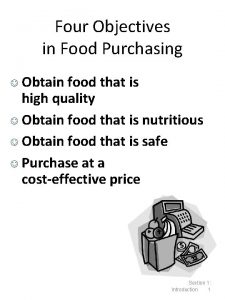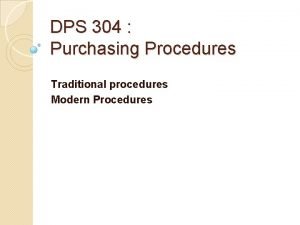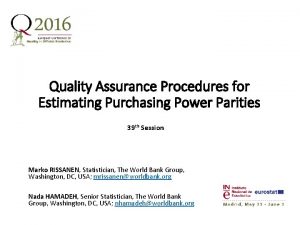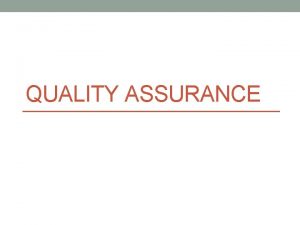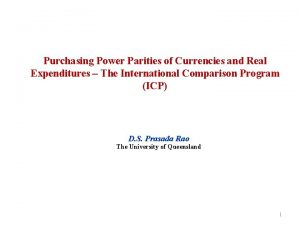Quality Assurance Procedures for Estimating Purchasing Power Parities










- Slides: 10

Quality Assurance Procedures for Estimating Purchasing Power Parities 39 th Session Marko RISSANEN, Statistician, The World Bank Group, Washington, DC, USA; mrissanen@worldbank. org Nada HAMADEH, Senior Statistician, The World Bank Group, Washington, DC, USA; nhamadeh@worldbank. org

Introduction: PPPs and ICP What are PPPs Purchasing power parities are conversion rates that convert to common currency while equalizing the purchasing power of different currencies Why use Accurate volume measures of economic activity, as well as comparisons of standards of living across countries, require PPPs conversion rates that take into account price levels What is ICP The International Comparison Program (ICP) is a worldwide statistical initiative designed to estimate PPPs; partnership of +200 countries, regional and global organizations

PPP Estimation Process Country National implementing agencies (NIAs) collect prices and related data for items (regional/global) covering a whole Level range of final goods and services (GDP) Regional implementing agencies (RIAs) use national prices to estimate regional PPPs: Level - At basic heading level (CPD: prices + missing prices) - Above the basic headings (GEKS: PPPs + exp. weights) Global Level Global ICP Unit (GIU) uses regional data to estimate global PPPs: - Global prices are used to calculate linking factors (CPD) - Regional PPPs are linked using the linking factors - Global PPPs are aggregated (GEKS) - Global PPPs are adjusted for fixity (CAR)

Overview of Quality Assurance Validation Stages • By NIAs • To ensure data quality within the country Intra-Country Validation Inter-Country Validation • By NIAs and RIAs • To ensure data quality and plausibility of the results within the region Generation of validation measures Iterative Process Correction Review • By RIAs and GIU • To ensure data quality and plausibility of the results across the regions Global Validation

Intra-Country Validation Initial Validation Review of merged datasets; item codes; observed quantities and units of measurement; sub-national price variations; temporal price variations Statistical Tests Review of average price measures: coefficients of variation; max/min ratios Review of individual price observation measures: standard deviations; t-values Data Finalization Preparation of average prices; number of observations; coefficients of variation

Inter-Country Validation Initial Validation Review for extreme data errors Validation at BH level Comparison of averages prices and related measures across the countries (main phase of the validation stage) Validation above BHs Comparison of averages prices and related measures across the countries above a single basic heading (BH) Temporal Validation Comparison of PPP and price level indices across time Data Preparation of final regional results and data for Finalization submission (after iterative rounds)

Example: Quaranta Table Milk, fresh, unskimmed, well known brand CTR AR BD BR CO GH ID KE KH MW NG PE PH VE VN ZA LCU price 14. 08 62. 31 2. 93 2, 726. 92 10. 18 20, 206. 00 122. 67 7, 960. 09 666. 69 466. 70 3. 63 79. 63 276. 88 35, 019. 00 12. 75 #Obs 132 86 726 162 35 294 24 6 30 279 80 179 165 276 88 CV 17 3 20 18 11 24 31 5 27 28 11 6 26 21 17 XR-Price XR-Index GM 1. 19 0. 98 82 0. 80 67 0. 75 63 0. 81 68 2. 58 216 1. 49 125 1. 21 102 1. 98 166 0. 91 76 2. 35 197 1. 04 87 1. 67 140 0. 69 58 1. 57 132 0. 79 67 CV 19. 2 PPP-Price PPP-Index GM 1. 19 0. 89 75 1. 09 91 0. 98 82 1. 06 89 1. 31 110 1. 23 103 1. 31 110 1. 60 134 1. 21 101 1. 47 123 0. 95 79 1. 34 112 0. 99 83 1. 69 142 1. 11 93

Global Validation Regional Quality Review of regional quality thresholds Global Price Quality Review of representativity of global prices among regional prices; quality of global prices across the countries; variability of the inter-regional linking factors Quality of Global PPPs Degree of similarity of aggregated bilateral PPPs (Paasche-Laspeyres spreads) Plausibility of Historical results; Penn-effect; Balassa–Samuelson Global Result effect

Example: Price Level vs GDP p. c.

Thank You Additional Resources Measuring the Real Size of the World Economy: The Framework, Methodology, and Results of the International Comparison Program Purchasing Power Parities and the Real Size of World Economies: A Comprehensive Report of the 2011 International Comparison Program Operational Guidelines and Procedures for Measuring the Real Size of the World Economy: 2011 International Comparison Program Follow Us Online http: //siteresources. worldbank. org/ICPEXT/Resources/I CP_2011. html
 Quality control and quality assurance
Quality control and quality assurance Pmp quality vs grade
Pmp quality vs grade Pmbok quality assurance vs quality control
Pmbok quality assurance vs quality control Quality assurance model in nursing
Quality assurance model in nursing Quality improvement vs quality assurance
Quality improvement vs quality assurance Concepts of quality control
Concepts of quality control Emergency purchase
Emergency purchase Purchase department structure
Purchase department structure Food objectives
Food objectives Modern purchasing procedures
Modern purchasing procedures Quality decisions as a purchasing and supply activity
Quality decisions as a purchasing and supply activity








